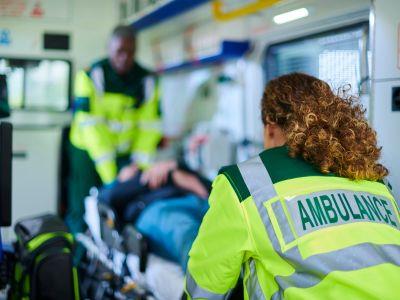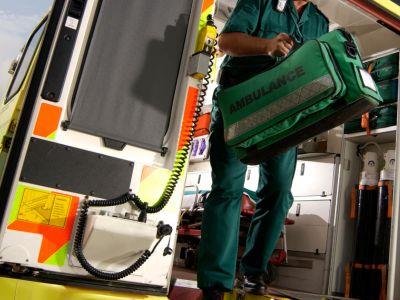
CRASH-4 is a multi-site randomised placebo-controlled trial, co-ordinated by the London School of Hygiene and Tropical Medicine, that aims to provide evidence about the effects of early administration of intramuscular Tranexamic Acid (TXA) on intracranial haemorrhage, disability, death, and dementia in older adults witha symptomatic head injury. CRASH-4 follows on from the CRASH-3 study, which showed the reduction in head injury deaths was largest in patients with mild to moderate head injuries if they were treated with TXA soon after injury. South Central Ambulance Service (SCAS) has been instrumental to the establishment of the trial in Wessex, and we caught up with the team to find out how their work is changing the lives of patients.
Reducing the Risks Associated with Head Injuries
Craig Jackson & Andy Claxton (Research Paramedics, South Central Ambulance Service): The CRASH-2 and CRASH-3 trials provided significant evidence for paramedic practice relating to the administration of TXA, so having the opportunity to be involved in CRASH-4, was something we did not want to miss. The outcomes of CRASH-3 identified the benefits of administering TXA to patients with a Glasgow Coma Scale of less than 13 after a severe head injury. The study found that mortality was reduced by a third, and the sooner TXA is administered the greater the positive effect. In fact, the last iteration of head injury guidelines from NICE suggests TXA within two hours for head injuries. Our patients are pre-hospital, so no CT scan has taken place, and they often have a more mild or moderate head injury, which is not always obviously serious.

When assessing older people for head injuries, it’s surprising how few symptoms they can present with but still have an underlying significant brain injury. This trial is designed to follow on from the impact of CRASH-2 and 3, to see how we can deliver the best care using TXA in a quick time frame for patients with mild to moderate traumatic brain injury. In the sporting world we’ve seen what blows to the head can do with regards to onset of dementia and Alzheimer’s disease and the study has considered these diseases as a secondary outcome. It asks whether this medicine can also stop or reduce the likelihood of developing these diseases post-head injury. The study started back in 2021, and is recruiting until Nov 2025 across multiple ambulance service and hospital sites. Initially, the patient is randomised via administration of Investigational Medicinal Product(IMP) within three hours of head injury. The discharge follow up, considers the patient’s condition and treatment whilst in hospital such as whether they had a CT scan, or a bleed, for example. This is followed by a day-28 post randomisation follow-up to monitor for adverse events requiring re-admission into hospital. After 12 months, the London School of Tropical Medicine and Hygiene clinical trials team review patients’ medical records for adverse events and dementia diagnosis.
The Crash-4 Study and Collaboration
Craig & Andy: We’ve currently recruited 309 patients to the trial, making us the leading site for patient randomisation. Our model of working has been a major contributing factor in this success and collaborative working with hospital sites has supportedour recruitment. Many hospital sites initially didn’t have the capacity to complete patient follow-up due to post COVID-19 workloads, however, University Hospital Southampton(UHS) and Queen Alexandra Hospital(QA) in Portsmouth provided us with remote access to patient data, through letters of access, to enable us to follow up the patients we randomised.This was only possible, with the help and support of the central study team at the London School of Hygiene and Tropical Medicine, working to change the protocol from one of divided functions (ambulance service enrols and hospital team follows up), to one of integrated functions which allow us to do both. Without the help of the hospital teams, we wouldn’t have been able to make such an impact on the trial. Alongside this, we are the only ambulance service to have dedicated research rapid response vehicles.
This fleet of research-dedicated vehicles attend these incidents specifically, so that we can seek consent from patients regarding tria lparticipation thereafter randomising them without delay. If full patient consent is not appropriate at the time of treatment we can record verbal assent or defer consent and written consent can be sought later in hospital. With reductions in pressures, the UHSResearch Team can now complete follow up data collection for CRASH4 randomised participants transported to their Emergency Department (ED).This then increases our availability to respond to potential eligible patients.
Anna Foster & Kate Sheppard (Research Nurses, University Hospital Southampton): We receive an email alert from the paramedic team about the patient when they’ve been given CRASH-4 IMP, so that we can identify them when they come into the ED. If we are in hours, we find out what sort of consent the paramedic team has received (patient or relative) and we can seek consent if they were unable to get it from a patient or relative at the time of the injection. Once they are in hospital, we give the patient more information about the trial, and then we follow up either by looking at the CRASH4 database for details around the treatment they received in hospital and their symptoms or via phone with the patient themselves.
Craig & Andy: This approach has enabled us to seek an appropriate level of consent in all applicable emergency situations - giving patients the opportunity to be involved in research even if they might not have full capacity at that time. It helps us to administer the IMP quickly, as evidence shows it’s time-critical. Since TXA is a relatively safe drug that doesn’t have many interactions this feels like a safe and effective solution. It has also generated more collaborative opportunities for us, and the close working has made it really easy.
Anna & Kate: The level of communication between us and the paramedics has made this study so much easier. Their help recruiting is essential. Patients are normally already aware of the study when they come to us in hospital, because the paramedics have done so much already. We’re able to give the best opportunities and care to patients because of this collaboration, the paramedics are so good when they bring patients into the ED. This means we can give high quality care, despite the challenges we’re facing.

A Novel Way to Run Ambulance-Service Research
Craig & Andy: We are full time research paramedics, and we work across all of our trials. We can respond to any incident that maybe appropriate and randomise to a trial if the patient is eligible. We then support the patient journey, complete appropriate data collection and administrative tasks in the background. It allows us the ability to remain clinical and have patient contact whilst having research involvement and inclusion. This model also means that we can work from anywhere, so we work across lots of different ambulance stations, interacting with staff about research and answering questions. People now know us and know they can approach us to to discuss research. In September 2023 our paramedic registering body, Health and Care Professions Council, amended the wording in their professional standards to require registered clinicians to be actively engaging in research. Our approach makes this happen, ensuring that paramedics are actively engaging patients appropriately in research activities. Our research rapid response vehicles can respond to paramedic requests quickly, enabling them and patients to be involved in research easily. For the CRASH-4 study, we created pocket cards that we distributed to paramedics so that if they are on a call with a head injured patient that maybe suitable, they know how to quickly contact the rapid response vehicle so that we can attend and offer the opportunity to the patient.
We also provide opportunities for paramedics to complete on-station training for trials so that they can be involved and seek consent for trial participation from patients.This approach has provided the opportunity to develop research in the ambulance service in terms of broadening our research offering. The relationships we have developed across the ambulance service and beyond makes us brilliant advocates for research and has grown our ability t obring on more studies. We have hosted senior research staff from UHS and Wessex CRN on rapid response cars so that they can get a good understanding of what we can do and deliver. There is continuity and unity of all of the teams involved across services. There are lots of challenges around data sharing and taking part in research, but we’re proving it can work. A lot of the innovations we’re bringing on involve bravery in stepping outside our comfort zone. The (calculated) risks you take to build these relationships have been backedby our forward thinking and openminded leaders. Without them, wewouldn’t be where we are now.We need more ambulance-basedresearch to ensure that we’re giving the patient the right treatment delivered by the right person at the right time.
Anna & Kate: Patients should always be offered research if it’s appropriate – it’s how we can give better patient outcomes for them. We’re incredibly thankful for CRASH-4, the paramedics and for giving patients this opportunity.






